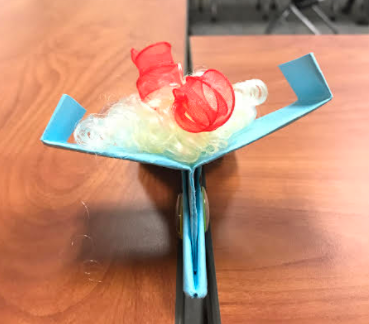


Variables within this Project:
Controlled Variables: Controlled variables are variables are are constant throughout an experiment. These variables are kept the same for each separate paper airplane in this instance. Here are some of the controlled variables of this project:
-
Spot where the airplane was thrown from
-
Throwing technique
-
Weather conditions in which the airplane was thrown
-
Number of trials per plane
Independent Variables:
Independent variables are variables that are believed to change the results of an experiment. These variables are not constant between the three different paper airplanes:
-
Paper type (card stock versus copy paper)
-
Paper weight (and whether or not the whole sheet of paper is used)
-
Optional: decorations and the weight of decorations used
Paper Airplane Data and Graph
Paper Airplane Launch
For this project, we were tasked with designing an experiment to test three different designs of paper airplane. The purpose of this experiment was to answer the following questions: Which paper airplane design will make the airplane stay in the air longer, and which design will make the airplane travel the longest distance?

Paper Airplane Launch #3
My Findings:
In working through this challenge, I worked to find the answers to several questions. Keep reading below to see my findings:
What makes the plane go forward? When I throw the paper airplanes, my arm moves backwards, moves forwards, and then I let go of the plane. When I let go of the plane, the potential energy that I am producing turns into the kinetic energy of the paper airplane. When the airplane is in the air, it is acted upon my three forces: weight, lift, and drag. Lift is the forces that "directly opposes the weight of an airplane and holds the airplane in the air."Lift is generated when the moving flow of air is disrupted by a solid object (a paper airplane, in this case). This definition of life answers the question, "What keeps the airplane from falling as quickly as if I dropped it?". Drag is the aerodynamic force that "opposes an aircraft's motion through the air." We can think of drag as "aerodynamic friction", which can be thought of as what slows the airplane down as it is in the air. Finally, weight is a force that comes from the gravitational pull that the Earth has on the paper airplane. Weight is not a aerodynamic force, but a field force; the "source of the force does not have to be in physical contact with the object to generate a pull on the object" (this is what eventually pulls the plane back down onto the ground, instead of the plane flying and flying). In the case of my paper airplanes, there needs to be a balance of weight: there needs to be enough weight for gravity to have a significant impact on the plane, but it also needs to be light enough to be kept in the air (by lift) and pushed forward (by drag).
.
The explanations of the forces that are acted upon the paper airplanes come from the NASA Paper Airplanes page. Click the star button to be redirected to NASA's website!









